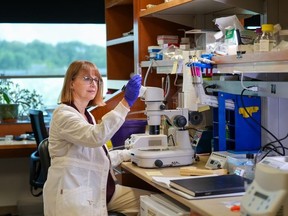Health
Scientists Uncover Mechanism Behind Chromosomal Anomalies Linked to Infertility

Researchers have made significant strides in understanding a genetic anomaly associated with infertility, known as Robertsonian translocation. This condition occurs when two chromosomes fuse together, resulting in individuals having fewer than the standard 46 chromosomes. Approximately 1 in 800 people carry this abnormality, often unaware until they encounter reproductive challenges.
On March 15, 2024, a study published in the journal Nature by a team at the Stowers Institute for Medical Research in Missouri revealed new insights into how these chromosomal rearrangements happen in humans. Utilizing advanced genome sequencing technologies, the researchers analyzed the fused chromosomes of three individuals, shedding light on the mechanisms behind these genetic anomalies.
The study highlights that regions of DNA previously dismissed as “junk” actually play a crucial role in the fusion of chromosomes. Understanding how Robertsonian translocations form is foundational science and may not lead to immediate health solutions. Nevertheless, it opens avenues for further research, particularly in identifying individuals who carry these genetic anomalies and assessing their risks for infertility, cancers, or rare diseases.
Glennis Logsdon, a genome scientist at the University of Pennsylvania Perelman School of Medicine, commented, “In my genetics classes, it was taught how this could lead to functional consequences – infertility and perhaps cancer. The conversation always stopped there: We don’t know how it happens. That’s where this paper picks up.”
The first draft of the human genome was published in 2001, costing approximately $3 billion. Yet, around 8 percent of the genome remained uncharacterized. Recent advances allowed for the completion of the human genome in 2022, highlighting significant areas that were previously overlooked. Jennifer Gerton, a chromosome biologist at Stowers, emphasized that many are unaware of the gaps in our understanding of human genetics.
Typically, humans possess 46 chromosomes, which are structures of DNA wrapped around proteins. During cell division, chromosomes condense into an X-shape. Some chromosomes, particularly the acrocentric ones, can become rearranged, resulting in the unusual fusion seen in Robertsonian translocations. These anomalies frequently surface during reproductive attempts, often leading to miscarriages or chromosomal abnormalities in offspring, such as Down syndrome.
The researchers utilized cutting-edge sequencing techniques to analyze repetitive DNA segments on the short arms of several chromosomes. These regions had been challenging to study with older sequencing methods, which often fragmented the genome into smaller pieces. Adam Phillippy, director of the Center for Genomics and Data Science at the National Human Genome Research Institute, likened previous methods to assembling a jigsaw puzzle using tiny pieces, making it difficult to visualize larger patterns.
The new study identified specific “recombination hotspots” where chromosomes align, break, and exchange genetic material. Notably, the research revealed that chromosome 14 has a unique configuration that predisposes it to these translocations. This discovery allows researchers to better understand how these genetic anomalies occur.
Moving forward, Phillippy’s team is utilizing genetic databases to identify individuals with Robertsonian chromosomes to assess their susceptibility to various health risks. André Marques, a group leader at the Max Planck Institute for Plant Breeding Research, remarked, “The study really shows how a human chromosome can fuse together, a long-standing mystery that helps a lot to explain both genetic disease and also the engine of chromosomal evolution.”
This research not only deepens our understanding of genetic disorders but may also lead to new tools that help individuals comprehend their reproductive risks more effectively.
-

 Education3 months ago
Education3 months agoBrandon University’s Failed $5 Million Project Sparks Oversight Review
-

 Science4 months ago
Science4 months agoMicrosoft Confirms U.S. Law Overrules Canadian Data Sovereignty
-

 Lifestyle3 months ago
Lifestyle3 months agoWinnipeg Celebrates Culinary Creativity During Le Burger Week 2025
-

 Health4 months ago
Health4 months agoMontreal’s Groupe Marcelle Leads Canadian Cosmetic Industry Growth
-

 Science4 months ago
Science4 months agoTech Innovator Amandipp Singh Transforms Hiring for Disabled
-

 Technology4 months ago
Technology4 months agoDragon Ball: Sparking! Zero Launching on Switch and Switch 2 This November
-

 Education4 months ago
Education4 months agoRed River College Launches New Programs to Address Industry Needs
-

 Technology4 months ago
Technology4 months agoGoogle Pixel 10 Pro Fold Specs Unveiled Ahead of Launch
-

 Business3 months ago
Business3 months agoRocket Lab Reports Strong Q2 2025 Revenue Growth and Future Plans
-

 Technology2 months ago
Technology2 months agoDiscord Faces Serious Security Breach Affecting Millions
-

 Education4 months ago
Education4 months agoAlberta Teachers’ Strike: Potential Impacts on Students and Families
-

 Education3 months ago
Education3 months agoNew SĆIȺNEW̱ SṮEȽIṮḴEȽ Elementary Opens in Langford for 2025/2026 Year
-

 Science4 months ago
Science4 months agoChina’s Wukong Spacesuit Sets New Standard for AI in Space
-

 Business4 months ago
Business4 months agoBNA Brewing to Open New Bowling Alley in Downtown Penticton
-

 Business4 months ago
Business4 months agoNew Estimates Reveal ChatGPT-5 Energy Use Could Soar
-

 Technology4 months ago
Technology4 months agoWorld of Warcraft Players Buzz Over 19-Quest Bee Challenge
-

 Business4 months ago
Business4 months agoDawson City Residents Rally Around Buy Canadian Movement
-

 Technology4 months ago
Technology4 months agoFuture Entertainment Launches DDoD with Gameplay Trailer Showcase
-

 Technology2 months ago
Technology2 months agoHuawei MatePad 12X Redefines Tablet Experience for Professionals
-

 Top Stories3 months ago
Top Stories3 months agoBlue Jays Shift José Berríos to Bullpen Ahead of Playoffs
-

 Technology4 months ago
Technology4 months agoGlobal Launch of Ragnarok M: Classic Set for September 3, 2025
-

 Technology4 months ago
Technology4 months agoInnovative 140W GaN Travel Adapter Combines Power and Convenience
-

 Science4 months ago
Science4 months agoXi Labs Innovates with New AI Operating System Set for 2025 Launch
-

 Technology4 months ago
Technology4 months agoNew IDR01 Smart Ring Offers Advanced Sports Tracking for $169










